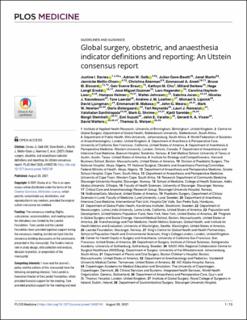Global surgery, obstetric, and anaesthesia indicator definitions and reporting: An Utstein consensus report
| dc.contributor.author | Davies, Justine I | |
| dc.contributor.author | Gelb, Adrian W. | |
| dc.contributor.author | Gore-Booth, Julian | |
| dc.contributor.author | Martin, Janet | |
| dc.contributor.author | Mellin-Olsen, Jannicke | |
| dc.contributor.author | Åkerman, Christina | |
| dc.contributor.author | Ameh, Emmanuel A. | |
| dc.contributor.author | Biccard, Bruce M. | |
| dc.contributor.author | Braut, Geir Sverre | |
| dc.contributor.author | Chu, Kathryn M. | |
| dc.contributor.author | Derbew, Miliard | |
| dc.contributor.author | Ersdal, Hege Langli | |
| dc.contributor.author | Guzman, Jose Miguel | |
| dc.contributor.author | Hagander, Lars | |
| dc.contributor.author | Haylock-Loor, Carolina | |
| dc.contributor.author | Holmer, Hampus | |
| dc.contributor.author | Johnson, Walter | |
| dc.contributor.author | Juran, Sabrina | |
| dc.contributor.author | Kassebaum, Nicolas J. | |
| dc.contributor.author | Lærdal, Tore | |
| dc.contributor.author | Leather, Andrew J.M. | |
| dc.contributor.author | Lipnick, Michael S. | |
| dc.contributor.author | Ljungman, David | |
| dc.contributor.author | Makasa, Emmanuel Malabo Mwenda | |
| dc.contributor.author | Meara, John G. | |
| dc.contributor.author | Newton, Mark W. | |
| dc.contributor.author | Østergaard, Doris | |
| dc.contributor.author | Reynolds, Teri | |
| dc.contributor.author | Romanzi, Lauri J. | |
| dc.contributor.author | Santhirapala, Vatshalan | |
| dc.contributor.author | Shrime, Mark G. | |
| dc.contributor.author | Søreide, Kjetil | |
| dc.contributor.author | Steinholt, Margit | |
| dc.contributor.author | Suzuki, Emi | |
| dc.contributor.author | Varallo, John E. | |
| dc.contributor.author | Visser, Gerard H.A. | |
| dc.contributor.author | Watters, David | |
| dc.contributor.author | Weiser, Thomas G. | |
| dc.date.accessioned | 2022-01-31T09:37:51Z | |
| dc.date.available | 2022-01-31T09:37:51Z | |
| dc.date.created | 2022-01-11T11:40:56Z | |
| dc.date.issued | 2021 | |
| dc.identifier.issn | 1549-1277 | |
| dc.identifier.uri | https://hdl.handle.net/11250/2975864 | |
| dc.description.abstract | Background Indicators to evaluate progress towards timely access to safe surgical, anaesthesia, and obstetric (SAO) care were proposed in 2015 by the Lancet Commission on Global Surgery. These aimed to capture access to surgery, surgical workforce, surgical volume, perioperative mortality rate, and catastrophic and impoverishing financial consequences of surgery. Despite being rapidly taken up by practitioners, data points from which to derive the indicators were not defined, limiting comparability across time or settings. We convened global experts to evaluate and explicitly define—for the first time—the indicators to improve comparability and support achievement of 2030 goals to improve access to safe affordable surgical and anaesthesia care globally. Methods and findings The Utstein process for developing and reporting guidelines through a consensus building process was followed. In-person discussions at a 2-day meeting were followed by an iterative process conducted by email and virtual group meetings until consensus was reached. The meeting was held between June 16 to 18, 2019; discussions continued until August 2020. Participants consisted of experts in surgery, anaesthesia, and obstetric care, data science, and health indicators from high-, middle-, and low-income countries. Considering each of the 6 indicators in turn, we refined overarching descriptions and agreed upon data points needed for construction of each indicator at current time (basic data points), and as each evolves over 2 to 5 (intermediate) and >5 year (full) time frames. We removed one of the original 6 indicators (one of 2 financial risk protection indicators was eliminated) and refined descriptions and defined data points required to construct the 5 remaining indicators: geospatial access, workforce, surgical volume, perioperative mortality, and catastrophic expenditure. A strength of the process was the number of people from global institutes and multilateral agencies involved in the collection and reporting of global health metrics; a limitation was the limited number of participants from low- or middle-income countries—who only made up 21% of the total attendees. Conclusions To track global progress towards timely access to quality SAO care, these indicators—at the basic level—should be implemented universally as soon as possible. Intermediate and full indicator sets should be achieved by all countries over time. Meanwhile, these evolutions can assist in the short term in developing national surgical plans and collecting more detailed data for research studies. | en_US |
| dc.language.iso | eng | en_US |
| dc.publisher | Public Library of Science | en_US |
| dc.rights | Navngivelse 4.0 Internasjonal | * |
| dc.rights.uri | http://creativecommons.org/licenses/by/4.0/deed.no | * |
| dc.title | Global surgery, obstetric, and anaesthesia indicator definitions and reporting: An Utstein consensus report | en_US |
| dc.type | Journal article | en_US |
| dc.type | Peer reviewed | en_US |
| dc.description.version | publishedVersion | en_US |
| dc.rights.holder | Copyright 2021 Davies et al. | en_US |
| dc.source.articlenumber | e1003749 | en_US |
| cristin.ispublished | true | |
| cristin.fulltext | original | |
| cristin.qualitycode | 2 | |
| dc.identifier.doi | 10.1371/journal.pmed.1003749 | |
| dc.identifier.cristin | 1978178 | |
| dc.source.journal | PLoS Medicine | en_US |
| dc.identifier.citation | PLoS Medicine. 2021, 18 (8), e1003749. | en_US |
| dc.source.volume | 18 | en_US |
| dc.source.issue | 8 | en_US |
Tilhørende fil(er)
Denne innførselen finnes i følgende samling(er)
-
Department of Clinical Medicine [2083]
-
Registrations from Cristin [10186]

